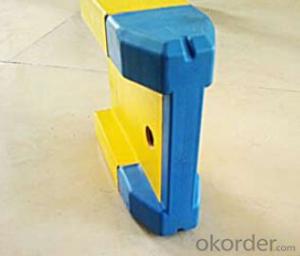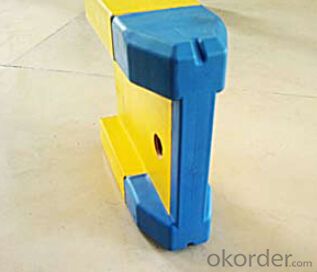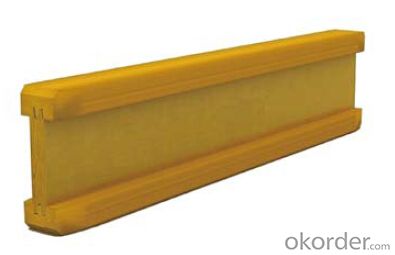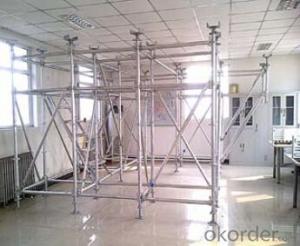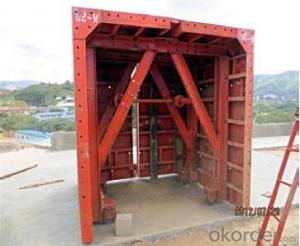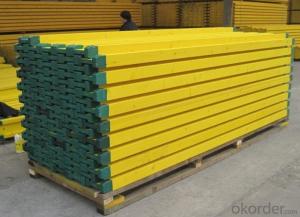Timber Beam Formwork for Building Construction
- Loading Port:
- Tianjin
- Payment Terms:
- TT OR LC
- Min Order Qty:
- 50 m²
- Supply Capability:
- 1000 m²/month
OKorder Service Pledge
Quality Product, Order Online Tracking, Timely Delivery
OKorder Financial Service
Credit Rating, Credit Services, Credit Purchasing
You Might Also Like
Plywood --- make perfect concrete surface
WISA-Form Birch is a coated special plywood using in the formwork systems where high
requirements are set on the concrete surface and the times of reuses.
With CNBM timber beam & WISA plywood, the formwork is low weight but high load capacity, it is
widely used in construction.
Characteristics:
◆ Component with high standardization.
◆ Assembling in site, flexible application.
◆ Light weight, easy transportation and storage.
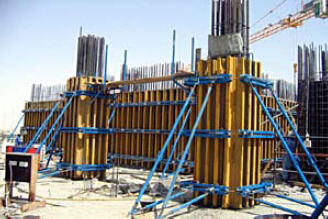

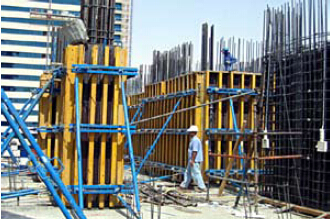
- Q: Is steel formwork reusable?
- Yes, steel formwork is reusable. It is a durable and sturdy material that can be dismantled and used multiple times for different construction projects.
- Q: Can steel formwork be used in sports facility construction projects?
- Yes, steel formwork can be used in sports facility construction projects. Steel formwork is a versatile and durable option that offers several advantages. Firstly, it provides a high level of strength and stability, making it suitable for large-scale structures like sports facilities. Steel formwork can withstand heavy loads and pressures, ensuring the integrity and safety of the construction. Additionally, steel formwork is highly reusable, which can significantly reduce construction costs and waste. It can be easily dismantled, cleaned, and reassembled for future projects, making it a sustainable choice for sports facility construction. Moreover, steel formwork allows for precise and accurate construction. Its rigidity and dimensional stability ensure that the desired shape and dimensions of the sports facility are achieved. This is particularly important in sports facilities where precise measurements and uniformity are crucial for proper functionality. Furthermore, steel formwork provides a smooth and uniform surface finish. This is essential in sports facilities where the playing surface needs to be even and consistent to ensure fair gameplay and prevent injuries. In summary, steel formwork is a suitable option for sports facility construction projects due to its strength, reusability, precision, and smooth surface finish. It offers numerous benefits and can contribute to the successful completion of sports facilities.
- Q: How does steel formwork handle concrete finishing and curing agents?
- Steel formwork, a material specifically designed for concrete finishing and curing, is highly durable and versatile. Its strength and rigidity ensure a stable structure for controlled pouring and curing of concrete. During the concrete finishing stage, steel formwork allows for the smooth and even application of various finishing agents like troweling, brushing, or spraying. The smooth surface of steel formwork facilitates easy application and manipulation of these agents, resulting in a uniform and aesthetically pleasing finish. Furthermore, steel formwork is resistant to chemical reactions with concrete curing agents. These curing agents, such as sealers, compounds, or coatings, enhance the strength, durability, and appearance of freshly poured concrete. Steel formwork's non-reactive nature allows for the application and absorption of these agents by the concrete without any negative impact on the formwork material. Moreover, steel formwork is non-absorbent, meaning it does not soak up moisture from curing agents or the concrete itself. This characteristic is vital during the curing process as it allows the concrete to maintain its moisture content, ensuring proper hydration and strength development. Additionally, the non-absorbent nature of steel formwork prevents potential damage or degradation that could arise from moisture absorption, expansion, or corrosion. In conclusion, steel formwork is an excellent choice for handling concrete finishing and curing agents due to its strength, rigidity, non-reactive nature, and non-absorbent properties. It provides a stable structure for applying finishing agents while supporting proper curing and moisture retention in the concrete.
- Q: What is the expected lifespan of steel formwork ties?
- The expected lifespan of steel formwork ties can vary depending on several factors such as the quality of the steel used, the conditions in which they are used, and how well they are maintained. However, in general, steel formwork ties are designed to have a long lifespan and can often be reused multiple times. High-quality steel formwork ties that are properly maintained and used in appropriate conditions can last for several years. With regular cleaning, inspection, and maintenance, they can be reused for multiple construction projects, which helps to reduce costs and waste. However, it is important to note that steel formwork ties can deteriorate over time, especially if they are exposed to harsh environmental conditions or corrosive substances. Therefore, it is crucial to regularly inspect the ties for any signs of damage or corrosion and replace them if necessary. Additionally, proper storage and handling of the ties when not in use can also help extend their lifespan. In conclusion, while there is no fixed lifespan for steel formwork ties, with proper maintenance and care, they can last for several years and be reused multiple times, making them a cost-effective and sustainable option for construction projects.
- Q: What are the different types of edge protection used with steel formwork?
- There are several types of edge protection used with steel formwork, including edge angles, chamfer strips, rubber profiles, and plastic edge protectors. These edge protection materials are used to ensure the safety of workers and prevent damage to the concrete edges during the formwork process.
- Q: What are the different types of accessories used in steel formwork systems?
- There are several types of accessories used in steel formwork systems, including form ties, wedges, clamps, scaffolding brackets, and alignment devices. These accessories play a crucial role in ensuring the stability and proper alignment of the formwork during the concrete pouring process.
- Q: How does steel formwork handle different concrete surface repair techniques?
- Steel formwork is highly versatile and can easily accommodate various concrete surface repair techniques. Its strong and durable structure allows for the application of techniques such as surface grinding, shot blasting, or sandblasting to remove damaged or deteriorated concrete. Additionally, steel formwork provides a smooth and stable surface, enhancing the effectiveness of techniques like patching, skim coating, or the application of bonding agents. Overall, steel formwork is compatible with a wide range of concrete surface repair techniques, making it a reliable choice for handling such repairs.
- Q: How does steel formwork handle different concrete pouring temperatures?
- Steel formwork is extremely durable and able to handle different concrete pouring temperatures with ease. The high strength and heat resistance properties of steel make it an ideal material for formwork in construction projects. When it comes to different concrete pouring temperatures, steel formwork remains stable and maintains its structural integrity. It does not warp or deform under extreme heat or cold, ensuring that the concrete retains its shape and structure during the pouring process. In hot weather conditions, steel formwork prevents rapid moisture loss from the concrete, which can lead to cracking and shrinkage. The steel acts as a barrier, reducing the impact of high temperatures on the concrete, and allowing it to cure properly. Similarly, in cold weather conditions, steel formwork helps to retain the heat generated during the concrete pouring process. This prevents freezing and ensures that the concrete sets and hardens correctly. The steel formwork also provides insulation, protecting the concrete from the harsh cold temperatures. Overall, steel formwork is highly adaptable and can withstand a wide range of concrete pouring temperatures. Its strength, durability, and resistance to heat and cold make it a reliable choice for handling different weather conditions during construction projects.
- Q: How does steel formwork handle concrete segregation?
- Due to its strength and durability, steel formwork is a popular choice in construction projects. Its role in handling concrete segregation is crucial, as it ensures a homogeneous mixture and prevents the separation of coarse aggregates from the concrete matrix. Concrete segregation occurs when the components of the concrete mixture, such as cement, water, aggregates, and admixtures, separate due to inadequate mixing or improper handling during placement. This can lead to weak spots, reduced strength, and compromised structural integrity. Steel formwork plays several key roles in preventing concrete segregation. Firstly, its rigid structure provides a stable and secure framework that holds the concrete in place during pouring and curing. This stability ensures that the concrete mixture remains intact and does not separate. In addition, steel formwork can be designed with various features to reduce segregation. For instance, tie rods, clamps, or brackets can be added to hold the form panels tightly together, preventing any movement or displacement of the concrete. These connections minimize the likelihood of aggregate separation and maintain a consistent mixture. Furthermore, the smooth surface of steel formwork prevents excessive bleeding and settlement of the concrete, which are common causes of segregation. The lack of surface irregularities or absorbent properties minimizes the escape of water and cement paste, ensuring a more uniform distribution of aggregates within the concrete. Moreover, steel formwork is easily cleaned and maintained, preventing the accumulation of hardened concrete or debris that could lead to segregation issues. Regular cleaning and inspection of the formwork help ensure that the concrete is poured into a clean and well-maintained mold, reducing the chances of segregation. In conclusion, steel formwork is an effective solution for preventing concrete segregation. Its rigid structure, secure connections, smooth surface, and easy maintenance all contribute to preventing the separation of aggregates from the concrete matrix. By utilizing steel formwork, construction projects can achieve a homogeneous and high-quality concrete placement, resulting in superior structural integrity and durability.
- Q: Can steel formwork be used for elevated slabs?
- Indeed, elevated slabs can be constructed using steel formwork. Steel formwork serves as a flexible and long-lasting choice for the construction of elevated slabs. It presents a robust and inflexible framework capable of withstanding the weight of the slab and any additional burdens. Moreover, steel formwork offers the added benefit of being reusable, thereby enabling savings in cost and enhancing efficiency in construction endeavors. Furthermore, steel formwork can be effortlessly modified and tailored to meet specific design requisites, rendering it suitable for diverse kinds of elevated slabs. In summary, due to its strength, durability, reusability, and adaptability, steel formwork stands as a dependable alternative for the construction of elevated slabs.
Send your message to us
Timber Beam Formwork for Building Construction
- Loading Port:
- Tianjin
- Payment Terms:
- TT OR LC
- Min Order Qty:
- 50 m²
- Supply Capability:
- 1000 m²/month
OKorder Service Pledge
Quality Product, Order Online Tracking, Timely Delivery
OKorder Financial Service
Credit Rating, Credit Services, Credit Purchasing
Similar products
Hot products
Hot Searches

